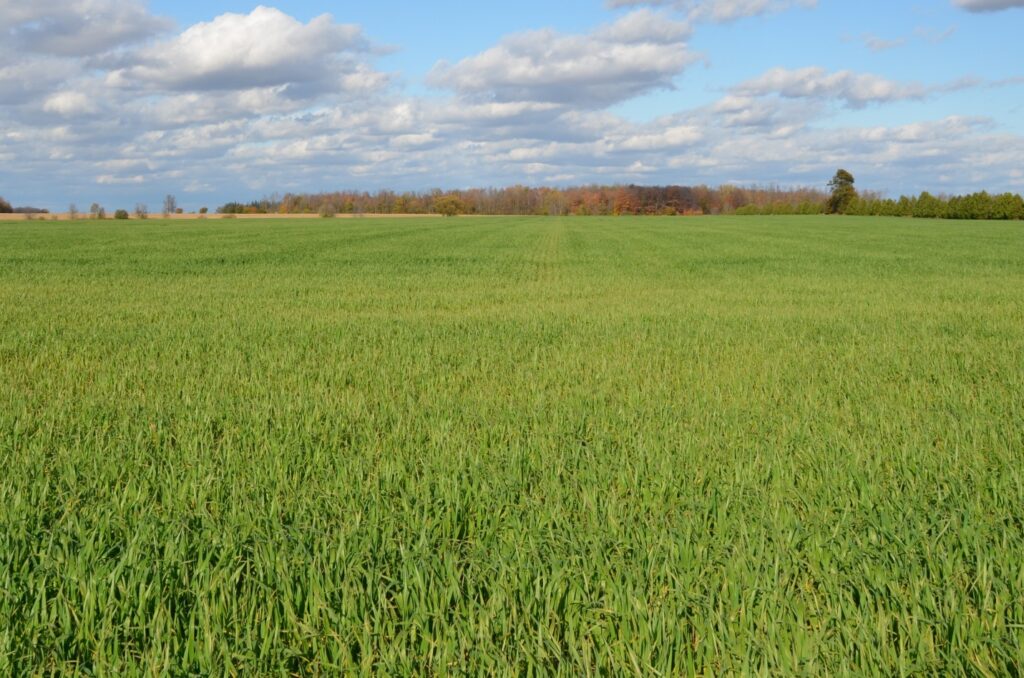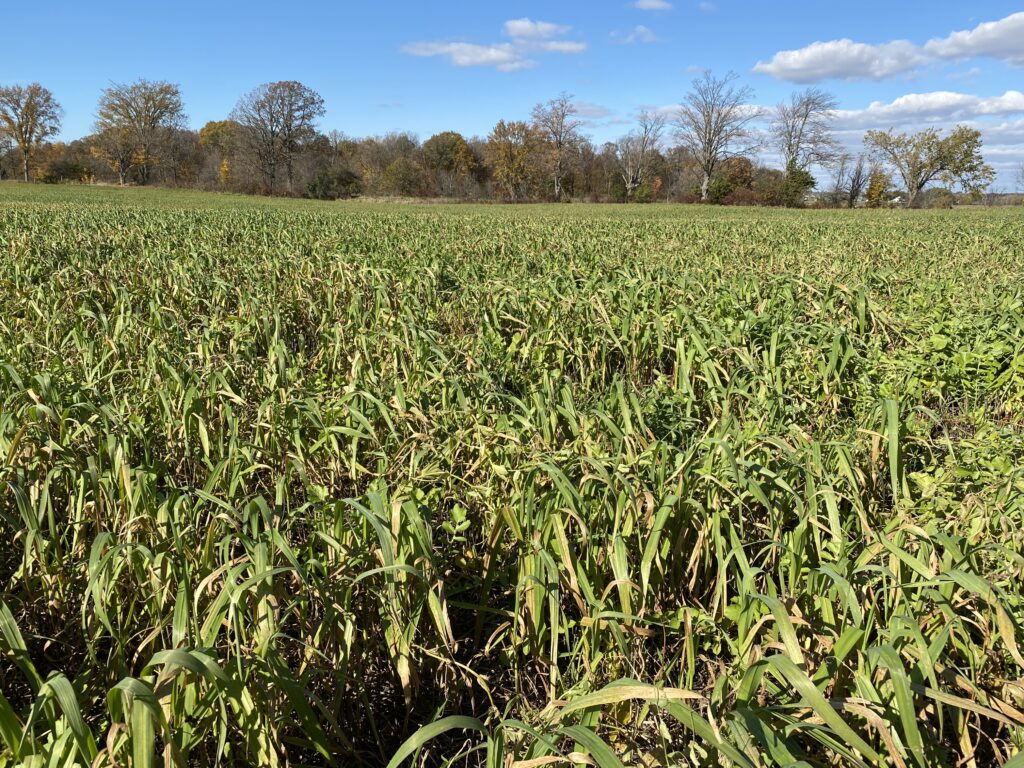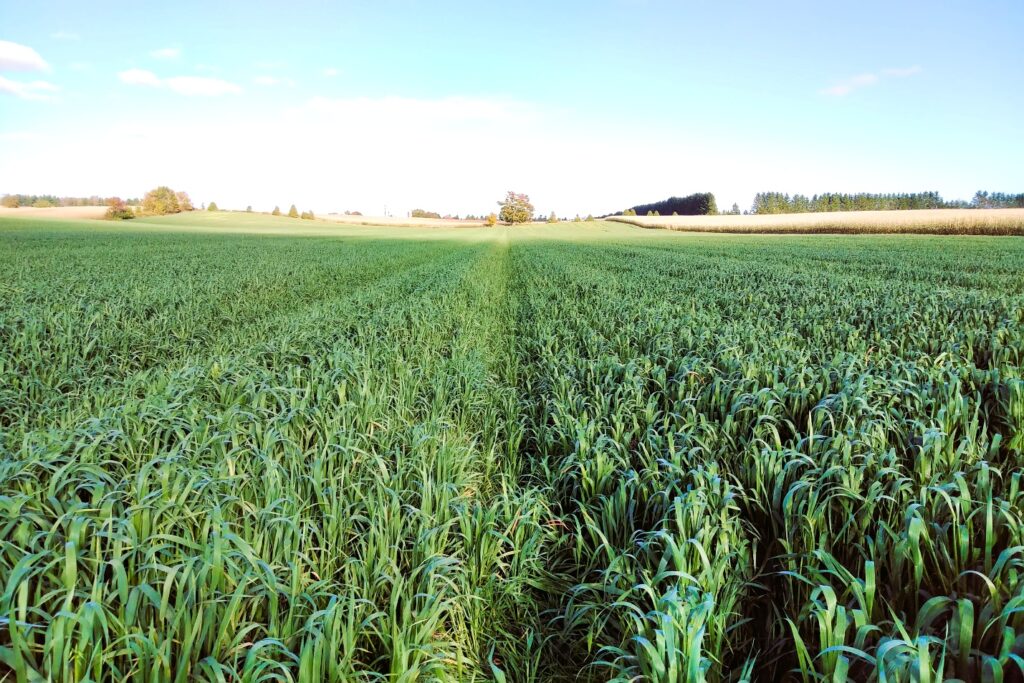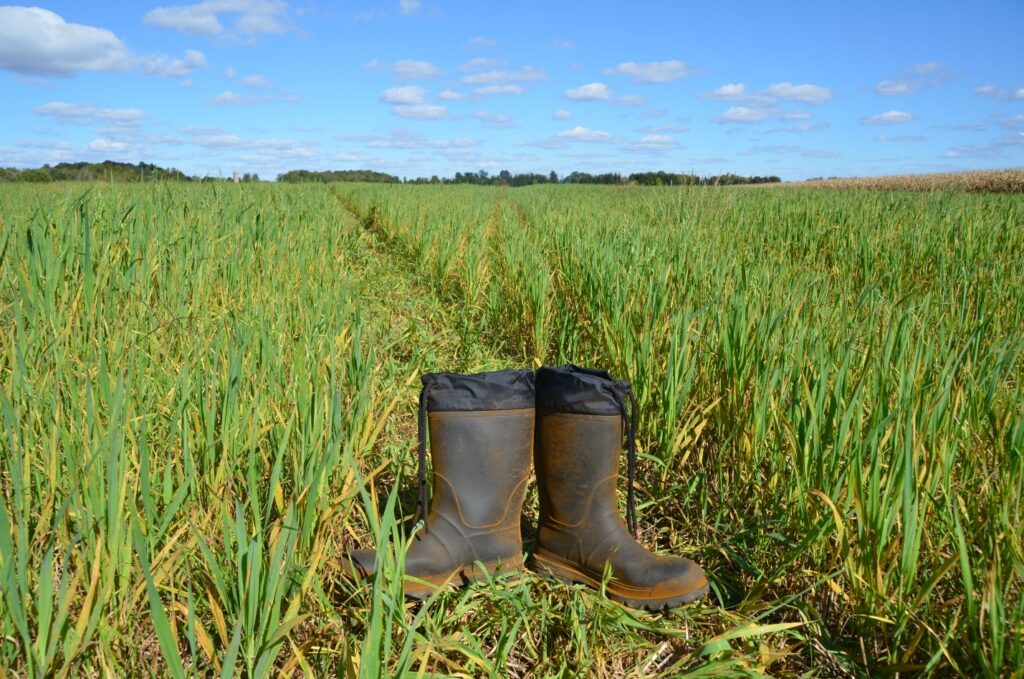Oats are a cool season cereal commonly grown as a cover crop either on their own (Figure 1) or as the base of mixtures. They establish quickly, grow rapidly, and typically die over winter. Oats provide benefits in terms of weed suppression, soil structure improvement, and as a harvested or grazed forage. They perform well across a wide range of soil textures and can provide lasting residue for erosion protection if given enough time to grow. Oats respond strongly to nitrogen supplied by manure and organic amendment applications and are also very good scavengers of nitrogen in soil. All these quality help make oats the most popular cover crop for Ontario farmers (Morrison and Lawley, 2021).

Figure 1. An oat cover crop in an Ontario field.
Establishment and growth
| Germination and emergence | Generally, cereals require 80 growing degree days (GDD) for germination and an added 50 GDDs for emergence for each inch of planting depth. Oats emerge and grow quickly relative to other cover crop species as long as soil temperatures are relatively warm. |
| Top growth | More upright growth habit and less tillering than barley. Full term crop can reach up to 1.3 m in height. Typical height achieved with August seedings ranges from 20 to 60 cm depending on fertility, soil moisture and termination timing. |
| Root system | Fibrous root system that aggregates soil well but is not as aggressive as rye. Majority of root system typically occurs in the topsoil (top 15-25 cm), but roots can reach as deep as 2 m depending on soil type, moisture conditions, and period of growth. |
| Overwintering | Oats will typically winterkill, though overwintering has been reported in warmer parts of southern Ontario, particularly following milder-than-normal winters. |
| Site suitability | Require moist soils for optimum growth. Do not perform well in hot, dry conditions. More tolerant of saturated soils than barley. Tolerate a larger pH range than wheat or barley. Preferred soil pH range is 6.5 to 5.0, but can tolerate as low as 4.5. |
| Herbicide sensitivity | Oats are tolerant of residues from most herbicides applied to the wheat crop in-season before flag leaf emergence. Check re-cropping information on the Ontario Crop Protection to confirm. |
Common uses in field crop rotations
- Drilled or broadcast and incorporated following winter wheat harvest at a modest rate (e.g., 20-50 kg/ha (18-45 lbs/acre)) on its own or with other species with complementary growth habits such as peas or radish (Figure 2)
- Drilled at a heavier rate (e.g., 80-100 kg/ha (70-89 lbs/acre)) following winter wheat harvest with or without field peas, fertilized with manure, organic amendment, or commercial fertilizer, and harvested for forage (Figure 3) or grazed

Figure 2. Oat-based cover crop with peas and radish with some frost damage in late fall.

Figure 3. Oats seeded for the purpose of mechanical forage harvest.
Control options
Weather
- Oats typically winterkill, though some reports of overwintering have been made following mild winters with good snow cover in southern Ontario
- Temperatures of -8 °C will kill oats at the seedling stage
Herbicides
- Oats are easily controlled with glyphosate or specific grass herbicides if unexpected overwintering occurs or if an oat cover crop is seeded in early spring
- A fall herbicide application may be done to control volunteer wheat and/or other problem weeds such as perennials
Mechanical
- Tillage is not required to terminate oats in Ontario’s climate
- Full-width tillage in fall minimizes the erosion control and soil structure benefits of an oat cover crop. Oat residue can break down significantly by spring, especially if seeding rate is modest and oats don’t fully head out.
Benefits and cautions
| Benefits | Cautions | |
| Nutrient management and organic matter | Oats capture nitrogen scavenged from soil or applied organic amendments and release it as the plant material decomposes. High biomass produced if well established early enough in the growing season (e.g., by mid-August in southern Ontario). | Oats may tie up nitrogen and make it less available to the following crop if allowed to become too mature (e.g., fully headed out). Mature, high carbon-to-nitrogen ratio oats may cause residue management challenges during seedbed preparation in spring without appropriate planning and equipment. |
| Pest and disease management | Oats are generally not expected to increase pest or disease pressure in the following crop. | Certain oat varieties are highly susceptible to crown rust, which can negatively affect cover crop growth potential when untreated (Figure 4). If present, alternate host buckthorn enables the fungal pathogen to overwinter and complete its lifecycle. Dead residue may provide a cooler, wetter, more favourable environment for slugs. |
| Erosion control | Oats stabilize soil with their fibrous roots and provide very good protection against water and wind erosion when surface residue is left undisturbed on the soil surface. | If conditions are too hot and dry, or too wet due to excessive rainfall and/or poor drainage, poor cover and erosion control will result. This is most common on sandy knolls and clay soils, respectively. |
| Soil moisture | Will tolerate wetter conditions than other grass cover crops. Can help dry saturated seedbeds while actively growing. | If oats are seeded thick, achieve strong growth, and head out in fall, they may slow soil drying in spring, particularly on clay soils. |

Figure 4. An oat cover crop affected by crown rust.
Getting started
- Seed is relatively inexpensive and readily available
- For best establishment and growth, bale of wheat straw or make sure straw and chaff are evenly spread
- Control volunteer wheat and any established weeds
- Drill or broadcast and incorporate seed. Broadcast seeding is less dependable and requires good rainfall shortly afterward but can be cost-effective and fast
- Oats respond strongly to added nutrients from organic amendments and perform best under cool, moist conditions
- Seed by late August or early September in much of southern Ontario to achieve adequate growth
Related resources
- Ontario Crop Protection Hub
- Midwest Cover Crops Council Cover Crop Decision Tool
- Ontario Cover Crop Recipe: After Wheat, Going to Corn or Soybean: Use an Oat-Radish Mix
References
Grigg, J., Ogilvie, C., Van Eerd, L. and Verhallen, A. 2021. Ontario Cover Crop Recipe: After Wheat, Going to Corn or Soybean: Use an Oat-Radish Mix. Midwest Cover Crops Council.
Morrison, C.L. and Y. Lawley. 2021. 2020 Ontario Cover Crop Feedback Report, Department of Plant Science, University of Manitoba. https://gfo.ca/wp-content/uploads/2021/12/Ontario-Report-V12-Dec-1st-For-PDF-conversion-for-publishing.pdf.